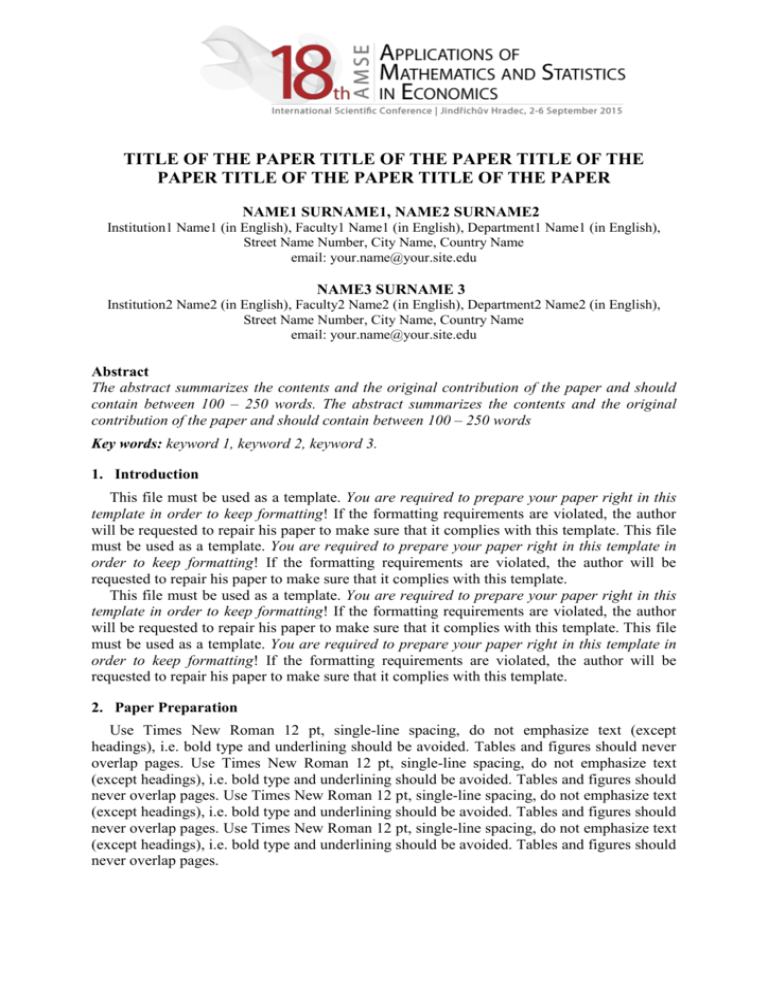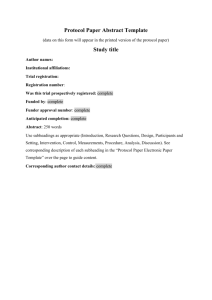title of the paper title of the paper title of the paper
advertisement

TITLE OF THE PAPER TITLE OF THE PAPER TITLE OF THE PAPER TITLE OF THE PAPER TITLE OF THE PAPER NAME1 SURNAME1, NAME2 SURNAME2 Institution1 Name1 (in English), Faculty1 Name1 (in English), Department1 Name1 (in English), Street Name Number, City Name, Country Name email: your.name@your.site.edu NAME3 SURNAME 3 Institution2 Name2 (in English), Faculty2 Name2 (in English), Department2 Name2 (in English), Street Name Number, City Name, Country Name email: your.name@your.site.edu Abstract The abstract summarizes the contents and the original contribution of the paper and should contain between 100 – 250 words. The abstract summarizes the contents and the original contribution of the paper and should contain between 100 – 250 words Key words: keyword 1, keyword 2, keyword 3. 1. Introduction This file must be used as a template. You are required to prepare your paper right in this template in order to keep formatting! If the formatting requirements are violated, the author will be requested to repair his paper to make sure that it complies with this template. This file must be used as a template. You are required to prepare your paper right in this template in order to keep formatting! If the formatting requirements are violated, the author will be requested to repair his paper to make sure that it complies with this template. This file must be used as a template. You are required to prepare your paper right in this template in order to keep formatting! If the formatting requirements are violated, the author will be requested to repair his paper to make sure that it complies with this template. This file must be used as a template. You are required to prepare your paper right in this template in order to keep formatting! If the formatting requirements are violated, the author will be requested to repair his paper to make sure that it complies with this template. 2. Paper Preparation Use Times New Roman 12 pt, single-line spacing, do not emphasize text (except headings), i.e. bold type and underlining should be avoided. Tables and figures should never overlap pages. Use Times New Roman 12 pt, single-line spacing, do not emphasize text (except headings), i.e. bold type and underlining should be avoided. Tables and figures should never overlap pages. Use Times New Roman 12 pt, single-line spacing, do not emphasize text (except headings), i.e. bold type and underlining should be avoided. Tables and figures should never overlap pages. Use Times New Roman 12 pt, single-line spacing, do not emphasize text (except headings), i.e. bold type and underlining should be avoided. Tables and figures should never overlap pages. Table 1.Font sizes of headings. Table captions should always be positioned above the tables centered between margins. Heading level Title (centered) 1st-level heading 2nd-level heading Font size and style 14 point, bold 12 point, bold 12 point, bold Source: Springer LNCS template. 2.1 Figures Line drawings should have a resolution of at least 800 dpi (preferably 1200 dpi).Graphs have to be black and white (halftones). If you send colored figures that are to be printed in black and white, please make sure that they really are legible in black and white. Line drawings should have a resolution of at least 800 dpi (preferably 1200 dpi).Graphs have to be black and white (halftones). If you send colored figures that are to be printed in black and white, please make sure that they really are legible in black and white. Figure 1 Figure captions should always be positioned under the figures, centered between margins Source: Springer LNCS template. 2.2 Formulas Displayed equations or formulas are centered and set on a separate line (with an extra line above and below). Displayed expressions should be numbered for reference. The numbers should be consecutive within the contribution, with numbers enclosed in parentheses and set on the right margin. When writing your equations between lines, please copy this sample equation line and then adjust it according to your needs. You must not use the Equation facility of Microsoft ® Word 2007/2010/2013. You may either write your equation directly or use the older Microsoft Equation 3 capability (Insert/Object/Microsoft Equation 3). x+y=z (1) 2.3 Citations Please use author (year, pages) or (author, year, pages) style for citations in the text. Please use (author, year) or (author, year, pages) style for citations in the text. Please use (author, year) or (author, year, pages) style for citations in the text. Please use (author, year) or (author, year, pages) style for citations in the text. 2.4 The References Section References have to be formatted following ISO 690 format and alphabetically ordered. If there are more than 3 authors, state the name of the first author and add “et al.”. Please base your references on the examples below. The required number of references is between 6 and 15. References have to be formatted following ISO 690 format and alphabetically ordered. If there are more than 3 authors, state the name of the first author and add “et al.”. Please base your references on the examples below. The required number of references is between 6 and 15. References have to be formatted following ISO 690 format and alphabetically ordered. If there are more than 3 authors, state the name of the first author and add “et al.”. Please base your references on the examples below. The required number of references is between 6 and 15. 3. Conclusion The introduction and the abstract must include the aim of the paper, the conclusion must summarize the content of the paper and show the original contribution of the paper. The introduction and the abstract must include the aim of the paper, the conclusion must summarize the content of the paper and show the original contribution of the paper. The introduction and the abstract must include the aim of the paper, the conclusion must summarize the content of the paper and show the original contribution of the paper. The introduction and the abstract must include the aim of the paper, the conclusion must summarize the content of the paper and show the original contribution of the paper. The introduction and the abstract must include the aim of the paper, the conclusion must summarize the content of the paper and show the original contribution of the paper. Acknowledgements The support of the grant scheme PROJECT NAME PROJECT NUMBER is gladly acknowledged. The support of the grant scheme PROJECT NAME PROJECT NUMBER is gladly acknowledged. The support of the grant scheme PROJECT NAME PROJECT NUMBER is gladly acknowledged. References 1. BATTESE, G. E., COELLI, T. 1992. Frontier production functions, technical efficiency and panel data: with application to paddy farmers in India. In Journal of Productivity Analysis, 1992, vol. 3, iss. 1-2, pp. 153-169. 2. CARMICHAEL, J. FLEMING, A., LLEWELLYN, D. 2004. Aligning Financial Supervisory Structures with Country Needs. Washington : World Bank Institute. 2004. ISBN 0-8213-6002-7 3 GOODHART, CH. A. E. 2000. The Organizational Structure of Banking Supervision. Basel: Financial Stability Institute. 2000. 41 pp. ISSN 1020-8461 4 GREENE, W. 2008. The econometric approach to efficiency analysis. In FRIED, H. O., LOVELL, C. A. K., SCHMIDT, S. S. (eds.) The measurement of productive efficiency and productivity growth. New York : Oxford University Press, 2008. ISBN 978-0-19518352-8. 5 NATIONAL BANK OF SLOVAKIA. 2012. Analysis of the Slovak financial sector for the first half of 2011. [cit. 21-04-2012] http://www.nbs.sk/_img/Documents/ _Dohlad/ORM/Analyzy/ASFS_1h2011.pdf 6 7 R CORE TEAM 2013: R: a language and environment for statistical computing. Vienna: R Foundation for Statistical Computing, 2012, http://www.r-project.org/. RMETRICS CORE TEAM, WUERTZ, D. 2011. fPortfolio: Rmetrics - Portfolio Selection and Optimization. R package, version 2130.80, http://cran.r-project.org/web/packages/ fPortfolio/ index.html





